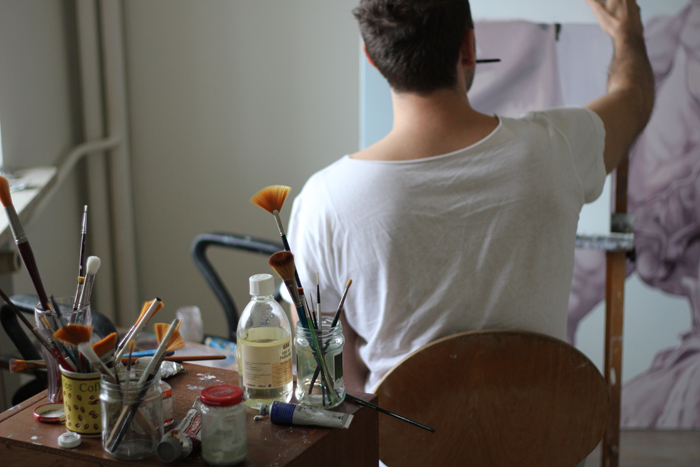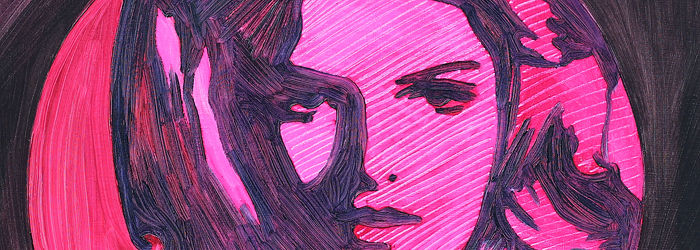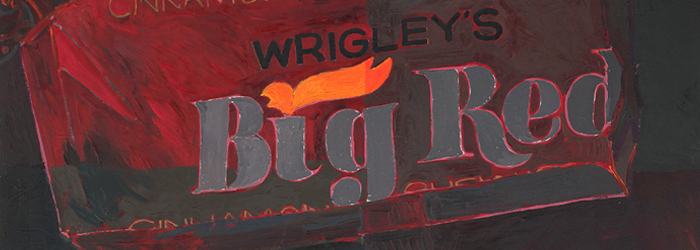
Andrzej Roszczak was born in 1974 in Krotoszyn and he lives in Warsaw. The basic medium used by Roszczak is figurative painting crafted though realism and sometimes reaching hyperrealism. After the graduation in art pedagogy from the University of Poznan (1995-1999), while having specialized in 3 different faculties; paintings under Professor Andrzej Niekrasz, sculpture under Professor Andrzej Jocz and graphics under Professor Andrzej Nawrot; the artwork of Roszaczak was initially focused on conceptual methods as he was working with different objects and materials and his paintings combined art with different integrated circuits found in old TV sets. During his studies Roszczak was interested in the matters related with sacrum and profanum ideas in association with the general communication matters and as a result he named his paintings after conceptual titles i.e. Information as a sensual creation of abstract form. Thinking process as a way of capturing and revealing the information. In 2007 – 2013 Roszczak makes oil paintings related to the dialogue with the past times, through the old photos documenting different events (Students revolutions’68, Stonewall’96), which are the starting point for him for further inspirations and considerations. In his paintings the major focus is given to a human being, who functions either as an individual or in a crowd, which influenced the problems and cultural and social changes of 1960s and 70s (Students 2010). Roszczak once again verifies, analyzes different social attitudes while uncovering ordinary cliché associated with the transmission and receipt of information (Astronauts).
POP-ART PERIOD (2002-2007)
Interests and fascination about pop-art in Roszczak workshop were directly linked with his 6 year co-operation with MTV. In addition to that it was also the time of settling down in Warsaw in a new environment known as the city of contrasts, which still has strong influence on him. Simplified and fast message which was typical for MTV is revealed in the paintings of Roszczak and loud and contrast colors start to dominate his workshop. In line with pop-art style Roszczak starts to create the series of paintings, where the main theme often remains unchanged while modifying and adjusting only colors (Le Male, Agnes – Amsterdam). In his opinion the color adjustments and multiplication of a theme was not the result of copying the art work by Andy Warhol – against whom he is often compared, but it was through the learning new tools such as graphic programs i.e. photoshop where the color adjustment is easy in modifying the theme in a very precise way. The latter was very useful for Roszczak in his research work on the influence of colors on shapes and one another.
In pop art period Roszczak ranges in different types of his own interests, but he is mainly focused on city iconosphere. The leading themes are the adverting photos, covers of fashion magazines which have the strongest influence on his imagination. In his artworks from the black period there are plenty of referrals to geometric shapes and abstract compositions. Roszczak combines the geometric figures with the synthesized shapes of the fashion model as a way of getting a sophisticated rhythm which nearly reaches abstraction (Woman in Composition). In series TV – Test Signal he redefines a well known TV control signal while making geometric shapes, drawings of technical architecture through the strong enhancement coming from contrast colors.
Pop art for Roszczak is first of all the time of research on the mutual influence of shapes and colors. Roszczak modifies the portraits of people in such a way that an optimal solution is always reached as he is looking for ideal shapes while combing a great level of synthesis with any sensual features of his people. The most recognized painting by him from this period is Le Male – a portrait of a young man based on the photograph from the advertising spot of the perfumes by Jean Paul Gaultier under the same title Le Male, which was synthesized to great extent and which had the highest number of different modifications.
It is interesting to know that at the same time Roszczak also created black paintings as a sort of contradiction to his pop art style, which had completely different message. The common feature of his pop art and black paintings is the subject of his inspirations; it is still urban iconosphere and the covers from fashion magazines. In his paintings Roszczak directly refers to advertising themes and spots, where through his style he tries to reanalyze and verify their real messages.
BLACK PERIOD SEE MORE
BLACK PERIOD (2004-2006)
Black period according to Roszczak has nothing to do with any depression that he was often suspected about. For the artist the exploration of deep, saturated and dark colors was the necessity for some kind of mind clearing and calmness. It is interesting to notice that paintings from the black period were made cyclically at the same time as with other pop art pieces although they were completely different from each other like from different galaxies. The common feature of these two different styles was the same themes which were picked by Roszczak from the urban iconosphere. The main objects of his paintings were still portraits of people, but sometimes there were also dead compositions. Roszczak did not cut himself from pop art as he still drew his inspirations from fashion photos from different magazines, but this time they were portrayed in a surprising way since expressive colors were replaced by extreme dark colors and the reduced motifs are enhanced through contour relief and think layer of paint which makes impasto. Despite the fact that paintings were originally linked with pop culture "noise" in the paintings by Roszczak, they change their own character and they embrace a new ‘’legibility’’. In 2006 black paintings were to signify for the coming changes in his artwork and professional life.
After having ended cooperation with MTV channel, the artwork of Andrzej Roszczak was drifted away from pop-art. The artist as enlarged his painting workshop with new painting styles and techniques. He starts to make paintings in realism making his artwork somehow a masterpiece that enables him drift his style towards hyperrealism workshop.
The period of early realism in the artwork of Roszczak is characterized by the thematic diversity as his scope of interests was enlarged gradually with new forms and at the beginning he still remained in the pop-art style. He is still motivated by the covers from fashion magazines, shots from movie frames and internet photos. However, you can notice new tendency in his paintings as he starts to cover different subjects and social attitudes. A gradual drift from media character of his workshop makes the artwork of Andrzej Roszczak more in line with the documentary style, where the main subject would be the exploration and analysis of photos from the past with the particular interests gives to 1960s and 1970s.
The situation will be changed in 2011 after the incident in Salzburg, where during a group exhibition at Hangart- 7 in Salzburg (where some of his paintings were shown), he receives a letter from a German photographer Rainer Schlegelmilch in which he is asked to explain the legal aspects of copy rights related to some of his paintings. After this incident Roszczak realized how complicated subject matter could be the allowed usage of certain themes and motifs from legal point of view. The latter resulted in his change of the artistic attitude and a personal crisis, which lasted almost one year.
© Roszczak 2012-2024







